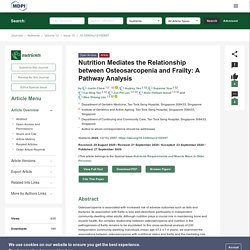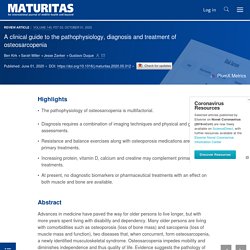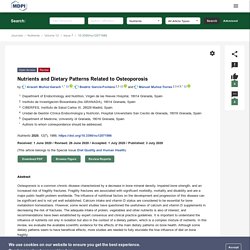

Vitamin K and Osteoporosis. 2.

Vitamin K Structure, Source, Cycle, Metabolism Vitamin K is the term used to name a family of fat-soluble compounds, which although differ in origin and/or function, share a common 2-methyl-1,4-naphthoquinone ring, but differ in the (lipophilic) side chains linked at the 3-position. The three main forms are vitamin PK or phylloquinone (PK), vitamin K2 or menaquinones (MKn) and vitamin K3 or menadione. These three forms can be differentiated by the 3-position: PK has an isoprenoid side chain, whereas the MK form possesses a phytyl side chain and is characterized by a variable number of connected isoprenoid units (MKn), and menadione has no side chain and is a synthetic analogue [4].
The sources of vitamin K are different depending on the vitamers. Fermented foods such as fermented butter or cheese, curdled cheese, egg yolk, and beef liver are sources of MKn. Vitamin PK, MK-4, and MK-7 are the currently commercially available formulations. 3. 4. 5. Table 1. 2. 3. 4. 5. Table 1. Nutrition Mediates the Relationship between Osteosarcopenia and Frailty: A Pathway Analysis. Osteosarcopenia is associated with increased risk of adverse outcomes such as falls and fractures.

Its association with frailty is less well-described, particularly in independent community-dwelling older adults. Although nutrition plays a crucial role in maintaining bone and muscle health, the complex relationship between osteosarcopenia and nutrition in the pathogenesis of frailty remains to be elucidated. In this cross-sectional analysis of 230 independent, community-dwelling individuals (mean age 67.2 ± 7.4 years), we examined the associations between osteosarcopenia with nutritional status and frailty, and the mediating role of nutrition in the association between osteosarcopenia and frailty. ►▼ Show Figures Figure 1 This is an open access article distributed under the Creative Commons Attribution License which permits unrestricted use, distribution, and reproduction in any medium, provided the original work is properly cited.
Calcium, vitamin D, vitamin K2, and magnesium supplementation and skeletal health - Maturitas. A clinical guide to the pathophysiology, diagnosis and treatment of osteosarcopenia - Maturitas. Reginster J.Y.

Beaudart C. Buckinx F. Bruyère O. Nutrients and Dietary Patterns Related to Osteoporosis. 2.1.

Calcium, Vitamin D and Dairy Products Calcium and vitamin D form part of the bone mineral matrix as calcium phosphate (hydroxyapatite crystals) and are required for bone strength. The best way to achieve adequate calcium intake is through adhering to a healthy diet. How to manage osteoporosis before the age of 50 - Maturitas. Clinical Practice Guidelines for the Diagnosis and Treatment of Postmenopausal Osteoporosis - 2020 Update.
Osteosarcopenia: epidemiology, diagnosis, and treatment—facts and numbers - Kirk - - Journal of Cachexia, Sarcopenia and Muscle. Introduction Healthy aging depends on the ability to maintain the reserve capacity of multiple physiological systems.

Of those, the musculoskeletal (MSK) system not only enables human ambulation but also serves as a major metabolic storage site (i.e. acts as a reservoir for calcium in bone as well as glucose in muscle). However, as an older person reaches their sixth decade of life, there is a progressive decline in bone mineral density (BMD) (~1–1.5% per year) and muscle mass (~1% per year) and strength (~2.5–3% per year),1, 2 which predisposes to the risk of osteoporosis and sarcopenia—two diseases with medical classifications listed by the International Classification of Diseases.
In 2010 alone, there was a respective 5.5 and 22 million men and women living with osteoporosis in the European Union, resulting in roughly 3.5 million fragility fractures and costing over €37 billion,10 a figure that is projected to increase by 25% in 2025. European Menopause and Andropause Society (EMAS) and International Gynecologic Cancer Society (IGCS) position statement on managing the menopause after gynecological cancer: focus on menopausal symptoms and osteoporosis - Maturitas.
3.3.1.

Summary recommendation. Pharmacological Management of Osteoporosis in Postmenopausal Women: An Endocrine Society* Clinical Practice Guideline. Skip to Main Content Sign In Register Close Advanced Search.

Dietary protein and bone health across the life-course: an updated systematic review and meta-analysis over 40 years. European guidance for the diagnosis and management of osteoporosis in postmenopausal women. Screening for Osteoporosis to Prevent Fractures US Preventive Services Task Force Recommendation Statement. Importance By 2020, approximately 12.3 million individuals in the United States older than 50 years are expected to have osteoporosis.

Osteoporotic fractures, particularly hip fractures, are associated with limitations in ambulation, chronic pain and disability, loss of independence, and decreased quality of life, and 21% to 30% of patients who experience a hip fracture die within 1 year. The prevalence of primary osteoporosis (ie, osteoporosis without underlying disease) increases with age and differs by race/ethnicity. With the aging of the US population, the potential preventable burden is likely to increase in future years. Objective To update the 2011 US Preventive Services Task Force (USPSTF) recommendation on screening for osteoporosis.
Guidelines for the management of osteoporosis and fragility fractures. 2017 American College of Rheumatology Guideline for the Prevention and Treatment of Glucocorticoid-Induced Osteoporosis - Buckley - 2017 - Arthritis & Rheumatology. Type 2 diabetes and osteoporosis: a guide to optimal management. Treatment of Low Bone Density or Osteoporosis to Prevent Fractures in Men and Women. Nutritional Influences on Bone Health -Book 2016. 2016 GUIDELINES FOR THE DIAGNOSIS AND TREATMENT OF POSTMENOPAUSAL OSTEOPOROSIS. The American Association of Clinical Endocrinologists/American College of Endocrinology Medical Guidelines for Practice are systematically developed statements to assist healthcare professionals in medical decision-making for specific clinical conditions.

Most of the content herein is based on literature reviews. In areas of uncertainty, professional judgment was applied. These guidelines are a working document that reflects the state of the field at the time of publication. Because rapid changes in this area are expected, periodic revisions are inevitable. We encourage medical professionals to use this information in conjunction with their best clinical judgment.
From 1Professor of Medicine, Loyola University Medical Center, Director, Loyola University Osteoporosis and Metabolic Bone Disease Center, Chicago, IL 2Associate Clinical Professor Weill-Cornell Medical College, Division Head Endocrinology and Chief of Endocrinology, Houston Methodist Hospital, Houston, TX. 2015 Life-course approach to nutrition for healthy skeleton. The prevalence of chronic kidney disease and end-stage renal disease among older people is increasing [92].

Diets which have low intakes of fruit and vegetables, and high intakes of cereal grains and protein, are increasingly common. Taken together, these two phenomena contribute to a low-grade, progressive metabolic acidosis among a growing number of older people. An acid environment has been shown to impair osteoblast function [93], accelerate bone resorption by enhancing osteoclast survival, adhesion, and migration [94], and also exert a direct negative physico-chemical effect on the bone [95]. 2015 position statement on peak bone mass development and lifestyle factors. 2015 National Osteoporosis Society practical clinical guideline on vitamin D and bone health. 2015 Calcium and vitamin D supplementation: state of the art for daily practice. 2014 National Osteoporosis Society Vitamin D Guideline Summary.
Skip to Main Content Sign In Register Advanced Search Journals Career Network Online ISSN 1468-2834 Print ISSN 0002-0729 Copyright © 2017 British Geriatrics Society Connect Resources Explore Oxford University Press is a department of the University of Oxford. 2013 Position Statement: Osteoporosis and Exercise. Osteoporosis has become an important health issue in North America for women of all ages, but especially those individuals in the postmenopausal age group and female endurance athletes.1 We need appropriate recommendations and relevant information for the prevention and treatment of osteoporosis for recreational and high level athletes. Data from Statistics Canada notes that, in the fiscal year 2003/2004, patients aged 60 or older requiring treatment at an acute care hospital for hip fracture totaled 23 621. Annual costs to Medicare for treatment of hip fractures are estimated at $650 million.2 Leslie et al have shown that age adjusted hip fracture rates in Canada have decreased in men and women since 1985.3 However, the absolute number of hip fractures continues to increase.
2013 Diagnosis and management of osteoporosis in postmenopausal women and older men in the UK: National Osteoporosis Guideline Group (NOGG) update. 2013 Vitamin D and Calcium Supplementation to Prevent Fractures in Adults: U.S. Preventive Services Task Force Recommendation Statement.